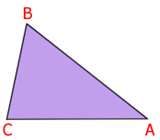Triangles Lesson: Exploring Different Types and Their Properties
Lesson Overview
- What Are Triangles?
- Properties of Triangles
- How to Calculate the Angles of a Triangle
- Identifying Triangles by Their Sides and Angles
Triangles are one of the simplest and most fundamental shapes in geometry. A triangle is a polygon with three sides and three angles. Understanding triangles is essential for solving problems in both geometry and real-life applications, such as construction, art, and engineering.
In this lesson, we will explore the different types of triangles, their properties, and how to classify them based on their sides and angles.
What Are Triangles?
A triangle is a closed 2D shape with three straight sides and three corners (or vertices). The sum of the internal angles of any triangle always equals 180 degrees.
Types of Triangles Based on Sides:
- Equilateral Triangle: A triangle with all three sides of equal length. All angles are also equal and measure 60 degrees each.
- Isosceles Triangle: A triangle with two sides of equal length and two equal angles.
- Scalene Triangle: A triangle with all three sides of different lengths and all angles of different measures.
Types of Triangles Based on Angles:
- Acute Triangle: A triangle where all three angles are less than 90 degrees.
- Right Triangle: A triangle with one angle equal to 90 degrees.
- Obtuse Triangle: A triangle with one angle greater than 90 degrees.
Properties of Triangles
Each type of triangle has unique properties that help define its shape and structure.
1. Equilateral Triangle:
- All three sides are equal in length.
- All three angles are equal and measure 60 degrees.
- It is a type of regular triangle (all sides and angles are the same).
2. Isosceles Triangle:
- Two sides are equal in length.
- The angles opposite these sides are equal.
- The third side can be a different length.
3. Scalene Triangle:
- All three sides are different in length.
- All three angles are different in size.
- It has no lines of symmetry.
4. Acute Triangle:
- All three angles are less than 90 degrees.
- It can be equilateral, isosceles, or scalene.
5. Right Triangle:
- One angle is exactly 90 degrees.
- It can be isosceles or scalene.
- The Pythagorean Theorem applies: a² + b² = c², where a and b are the lengths of the legs, and c is the length of the hypotenuse (the longest side).
6. Obtuse Triangle:
- One angle is greater than 90 degrees.
- The other two angles are acute (less than 90 degrees).
- It can be isosceles or scalene.
Take This Quiz:
How to Calculate the Angles of a Triangle
The sum of the three angles in any triangle is always 180 degrees. If you know the values of two angles, you can find the third by subtracting the sum of the two known angles from 180 degrees.
Example 1:
If two angles in a triangle are 50 degrees and 60 degrees, the third angle can be calculated as:
180−(50+60)=70 degrees
Example 2:
If a triangle has one angle of 90 degrees and the other two angles are 45 degrees, the third angle can be calculated as:
180−(90+45)=45 degrees
Identifying Triangles by Their Sides and Angles
You can classify triangles based on their side lengths and angles. Understanding the properties of each type of triangle makes it easier to identify them in real-life situations and math problems.
1. Equilateral Triangle:
- All sides and angles are equal.
- All three angles are 60 degrees.
2. Isosceles Triangle:
- Two sides are equal, and the angles opposite those sides are also equal.
- The third angle can be any value, but it will not be the same as the other two.
3. Scalene Triangle:
- All three sides are of different lengths.
- All three angles are of different sizes.
4. Acute Triangle:
- All three angles are less than 90 degrees.
- It can be equilateral, isosceles, or scalene.
5. Right Triangle:
- One angle is exactly 90 degrees.
- The other two angles are acute.
- The longest side is called the hypotenuse, and it is opposite the right angle.
6. Obtuse Triangle:
- One angle is greater than 90 degrees.
- The other two angles are acute.
Take This Quiz:
Examples of Triangles
Triangles are everywhere in the world around us. Some common examples of triangles include:
- Roof Trusses: Many roofs are made up of triangular trusses to help with stability and weight distribution.
- Pyramids: The sides of many pyramids, such as the Egyptian pyramids, are triangular.
- Traffic Signs: Many traffic signs, such as yield signs, are triangular in shape.
- Triangles in Nature: The shape of certain mountain peaks, like the Matterhorn, is triangular.
Practice Problems for Triangles
Let's test your understanding with a few practice problems:
- What type of triangle has three equal sides and three equal angles?
- If a triangle has angles of 50 degrees and 60 degrees, what is the third angle?
- What type of triangle has one angle of 90 degrees?
- How many degrees do the angles in a triangle always add up to?
Take This Quiz:
Rate this lesson:
 Back to top
Back to top

(57).jpg)
(37).jpg)